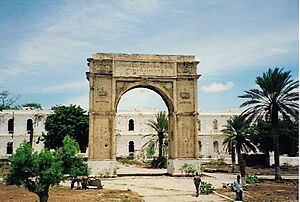Italian Mogadiscio facts for kids
Mogadiscio was the name for Mogadishu, the capital city of Somalia, when it was ruled by Italy. This period lasted from 1905 to 1947. Italian influence in Mogadishu lasted for about 80 years, from 1880 to 1960. During this time, the city grew a lot, from just 2,000 people to almost half a million!
Contents
History of Mogadiscio
Mogadishu was under Italian control for about 70 years, starting in the 1880s and ending after World War II. In 1905, it officially became the capital of a new Italian colony called Somalia Italiana.
Early Italian Influence
The famous Italian explorer Marco Polo was one of the first Italians to mention Mogadishu. He learned about the city during his travels in Asia. Later, in the late 1800s, an Italian trading company called "Filonardi" started to control the port of Mogadishu.
By 1882, Mogadishu was partly controlled by the Somali Geledi Sultanate and partly by the Omani Sultan of Zanzibar. In 1885, the city was leased to an Italian company led by Vincenzo Filonardi. The Italian government eventually took full control of the area, including the port of Mogadishu, in 1905. This made Mogadishu the capital of Italian Somaliland. The Italians then called the city Mogadiscio.
Modernizing the City
In the early 1910s, Mogadiscio started to become more modern. The city got its first sewage system, a hospital, paved roads, and electricity. In the 1920s, the Italians built the first airport and made the "Port of Mogadishu" much bigger.
From 1908 to 1936, a special military group called the Royal Corps of Somali Colonial Troops was based in Mogadiscio. Many Somalis from Mogadishu joined these troops and fought alongside Italian soldiers in wars.
In 1920, the first modern bank in Italian Somaliland, called Banca d'Italia, opened in Mogadiscio.
Growth and Development
In 1923, Cesare Maria De Vecchi became the Governor. He worked to bring peace to Italian Somaliland and help local people join the new system. The Italian rulers respected local traditions and the Islamic religion.
In 1928, the Italians built the beautiful Mogadishu Cathedral. It was designed in a Gothic style, similar to a cathedral in Sicily. To celebrate a visit from Italy's Crown Prince Umberto II, the Arch of Umberto was built in the city's garden. The Mogadishu International Airport was also built that same year and was considered one of the best in the region.
In the early 1930s, new Italian Governors encouraged more Somalis to join the colonial troops. Thousands of Italian people also moved to live in Mogadiscio. The city grew, and small factories started to open. Italians also began farming in areas around the capital, like Jowhar and Janale.
Mogadiscio was the only official name for the capital of Somalia from 1905 until February 1947. During these years, the only official language was Italian language.
By 1930, about 22,000 Italians lived in Italian Somaliland. Most of them lived in Mogadiscio. In the mid-1930s, the Italian community in Mogadishu started the first football championships in Somalia. Their main team was AC Mogadiscio.
Mogadiscio as a Key City
By 1935, Mogadiscio became an important naval base and port for the Italians. The Italian Prime Minister, Benito Mussolini, saw Mogadiscio as a very important part of Italy's empire in eastern Africa.
From 1936 to 1940, many new roads were built around Mogadiscio, including a main road from Mogadishu to Addis Abeba. New railways, schools, hospitals, ports, and bridges were also constructed.
In March 1941, the British Army took control of Mogadiscio. For safety reasons, many Italians in Somalia moved to Mogadiscio. By 1942, almost half of the city's population was Italian, and about 60% of people were Catholic. British reports from 1942 described Mogadiscio as looking like a European city, calling it "the white pearl of the Indian Ocean."
After World War II, in February 1947, the Italian government signed a peace treaty. This meant they gave up all their colonies, and "Italian Mogadiscio" officially ended.
Return and Independence
In 1950, the Italians returned to govern the city under a United Nations agreement. They ruled for another ten years until 1960, when Somalia became an independent country. During these ten years, the country saw many improvements in its economy, education, and even sports. For example, new football teams like Genio Officina and AC Mogadiscio were created.
Related pages



